WPA Conservation Projects - 1938
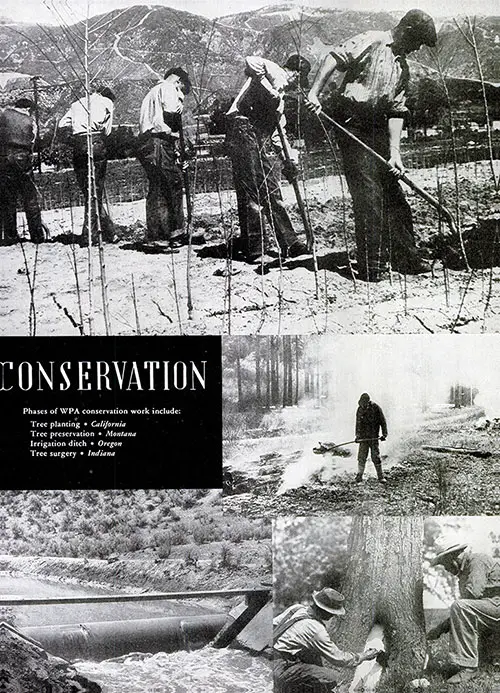
Phases of WPA Conservation Work Include Tree Planting (California), Tree Preservation (Montana), Irrigation Ditch (Oregon), Tree Surgery (Indiana). Inventory: An Appraisal of Results of the Works Progress Administration, Washington, DC: US Government Printing Office, 1938. GGA Image ID # 1520c925ec
The extensive and varied conservation program of the WPA has provided numerous important links in the drive of many Government agencies to check the destruction of natural resources and repair the ravages of former years. It is a program of long-range benefits.
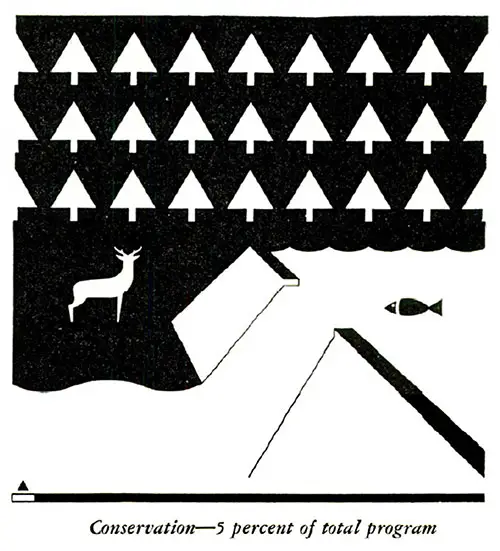
Conservation—5 Percent of Total Program. Inventory: An Appraisal of Results of the Works Progress Administration, Washington, DC: US Government Printing Office, 1938. GGA Image ID # 1521bbe4bd
The front-line battles put up by WPA workers against actual flood and drought will be detailed in another section of the report.
The purpose here is to examine their diverse work designed to anchor the lands which are blowing or washing away, to conserve and control water, to stop forest and prairie fire, and to aid in the propagation of wildlife.
Principally in drought areas, the WPA has built 3,504 new storage dams designed to capture spring freshets and retain them for the parching summer, as well as constructing 17,083 other dams, most of them small, for the dual purpose of better water control and of raising the subsurface water levels.
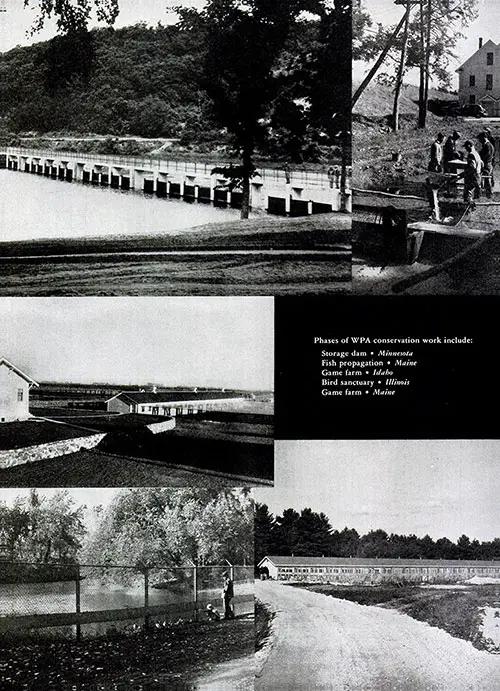
Other Phases of WPA Conservation Work Include Storage Dam (Minnesota), Fish Propagation (Maine), Game Farm (Idaho), Bird Sanctuary (Illinois), Game Farm (Maine). Inventory: An Appraisal of Results of the Works Progress Administration, Washington, DC: US Government Printing Office, 1938. GGA Image ID # 1520d46582
WPA workers have reforested 32,854 acres by planting 13,453,639 trees. In their work against forest fires they have cleared 1,227 miles of firebreaks, built 32 observation towers and constructed 2,125 miles of fire and forest trails.
Also, by establishing 625 plant and tree nurseries, they have produced and planted an additional 12,559,623 plants and trees. To improve river and stream banks and control floods, they have built over 170 miles of new levees and reconstructed 375 miles more, in the course of which they placed 17,700,000 cubic yards of earth.
They have improved 940 miles of riverbanks and 3,240 miles of stream beds. They have built 10,601 retaining walls, totaling over 400 miles in length, and improved 2,738 others.
They have built 53 miles of canals, exclusive of irrigation canals, 266,935 linear feet of bulkheads, and laid over 4,000,000 square yards of riprap in addition to that on riverbanks.
To aid in the propagation of wildlife, they have established 819 bird and game sanctuaries, and built 139 new fish hatcheries, with a capacity of over 336,000,000 fingerlings each year.
They also have improved or enlarged 81 existing hatcheries. The sealing of 67,327 openings in 7,777 abandoned mines, thus preventing large quantities of acid from polluting American streams, also is a campaign of significance to fishermen.
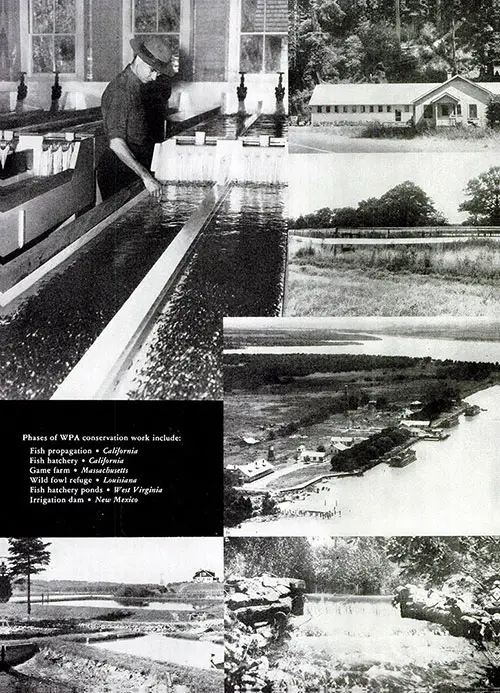
Additional Phases of WPA Conservation Work Include Fish Propagation (California), Fish Hatchery (California), Game Farm (Massachusetts), Wild Fowl Refuge (Louisiana), Fish Hatchery Ponds (West Virginia), Irrigation Dam (New Mexico). Inventory: An Appraisal of Results of the Works Progress Administration, Washington, DC: US Government Printing Office, 1938. GGA Image ID # 152186090e
Experts believe that many streams in the mining areas, from which game fish have been driven, soon may be restocked successfully. The preparation of 59,013 acres of oyster beds, and the planting of 2,633,143 bushels of oysters, has been carried out at the request of local officials whose aim is to rehabilitate professional fishermen by restoring their livelihood.
The WPA has performed a large amount of tree surgery, involving work on over 1,263,984 trees and the removal of 257,000 others which had become diseased.
It also has eradicated noxious plants over an area exceeding 6,300,000 acres and conducted wide campaigns against such insect pests as the Mormon cricket.
In these drives against both insects and weeds, WPA workers have used over 12,000 tons of poison food and 11,700,000 gallons of spray, distributing the latter over an area of 550,000 acres.
For irrigation, 226 miles of flumes or canals have been dug, bringing water to over 120,000 acres, while about ten times as much mileage of existing systems has been rehabilitated, affecting over 1,760,000 acres.
Mostly in the drought area, when water was at a premium, WPA workers dug a total of 1,632 public wells, and reclaimed 1,437 others. In ports and harbors, they have built 99 docks, wharves, or piers, and reconditioned 139 others. They also have constructed 1,161 jetties and breakwaters.
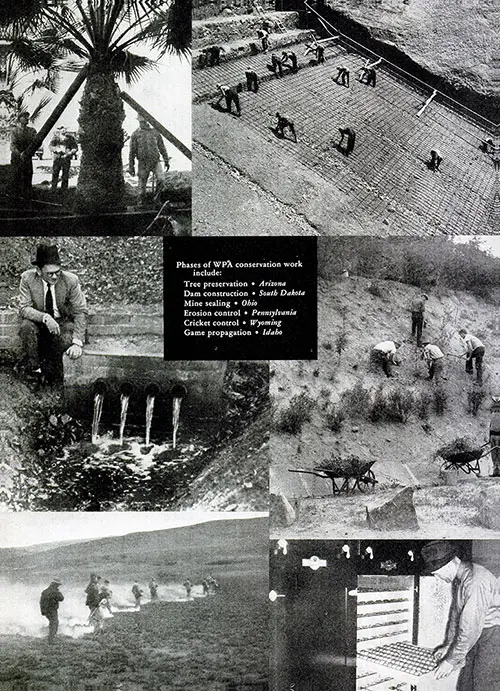
More Phases of WPA Conservation Work Include Tree Preservation (Arizona), Dam Construction (South Dakota), Mine Sealing (Ohio), Erosion Control (Pennsylvania), Cricket Control (Wyoming), Game Propagation (Idaho). Inventory: An Appraisal of Results of the Works Progress Administration, Washington, DC: US Government Printing Office, 1938. GGA Image ID # 1521ae06dd
"Conservation," in Inventory: An Appraisal of Results of the Works Progress Administration, Washington, DC: US Government Printing Office, 1938, pp. 49-54.

